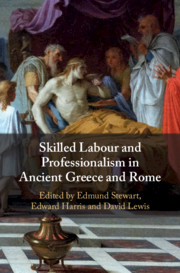Book contents
- Skilled Labour and Professionalism in Ancient Greece and Rome
- Skilled Labour and Professionalism in Ancient Greece and Rome
- Copyright page
- Contents
- Illustrations
- Contributors
- Acknowledgements
- Abbreviations
- Introduction
- Part I Professionals and Professional Identity in Greece and Rome
- Part II Specialization and the Division of Labour in the Ancient City
- Part III Case Studies of Professions 1: Sculpture
- 6 Professionalism in Archaic and Classical Sculpture in Athens: The Price of Technē
- 7 Artists beyond Athens: The Freedoms and Restrictions of the Artistic Profession in Classical Greece
- 8 Roman Sculptors at Work: Professional Practitioners?
- Part IV Case Studies of Professions 2: Music and Athletics
- Part V Case Studies of Professions 3: A Profession of Arms?
- Index
- References
7 - Artists beyond Athens: The Freedoms and Restrictions of the Artistic Profession in Classical Greece
from Part III - Case Studies of Professions 1: Sculpture
Published online by Cambridge University Press: 18 September 2020
- Skilled Labour and Professionalism in Ancient Greece and Rome
- Skilled Labour and Professionalism in Ancient Greece and Rome
- Copyright page
- Contents
- Illustrations
- Contributors
- Acknowledgements
- Abbreviations
- Introduction
- Part I Professionals and Professional Identity in Greece and Rome
- Part II Specialization and the Division of Labour in the Ancient City
- Part III Case Studies of Professions 1: Sculpture
- 6 Professionalism in Archaic and Classical Sculpture in Athens: The Price of Technē
- 7 Artists beyond Athens: The Freedoms and Restrictions of the Artistic Profession in Classical Greece
- 8 Roman Sculptors at Work: Professional Practitioners?
- Part IV Case Studies of Professions 2: Music and Athletics
- Part V Case Studies of Professions 3: A Profession of Arms?
- Index
- References
Summary
This chapter considers one particular piece of evidence for the perceived importance of artistic skill in the Greek world: the unrestricted mobility of artists. Skill is both a rare and portable commodity. High demand for skill may encourage travel, as artists are tempted by ever higher offers of pay in different locales. On the other hand, variable levels of demand may equally force artists to move in order to gain full employment. Crucially, the fact that Greek cities did not attempt to block the entry of foreign artists from hostile polities testifies to the widespread demand for skilled artists and the respect accorded to their craft.
- Type
- Chapter
- Information
- Skilled Labour and Professionalism in Ancient Greece and Rome , pp. 230 - 242Publisher: Cambridge University PressPrint publication year: 2020



